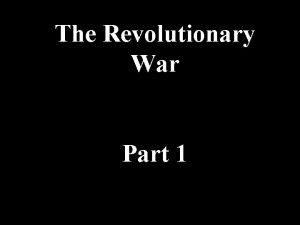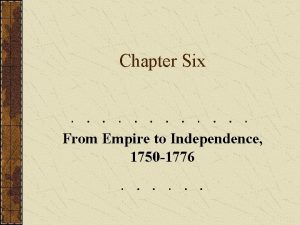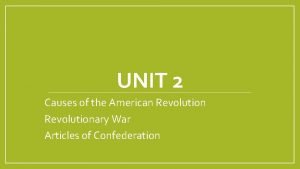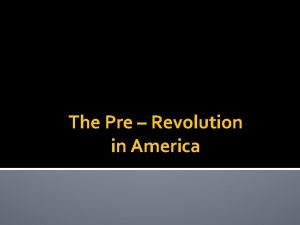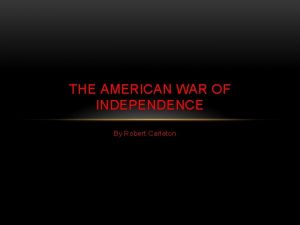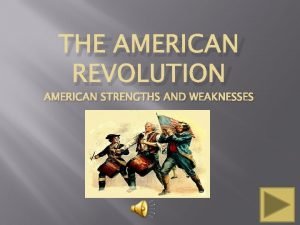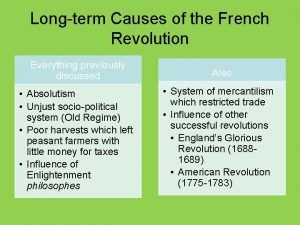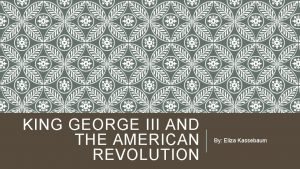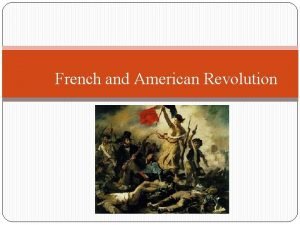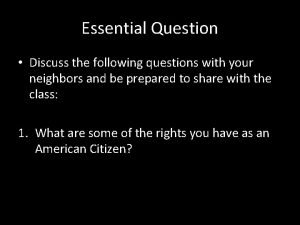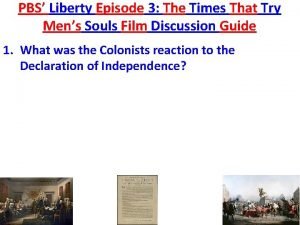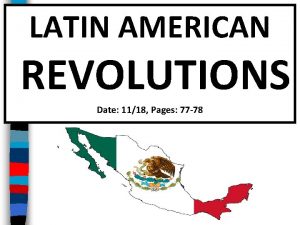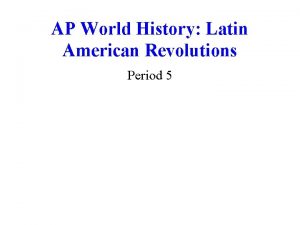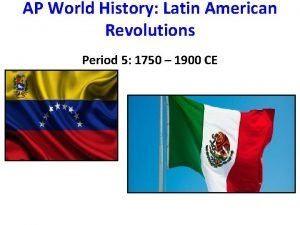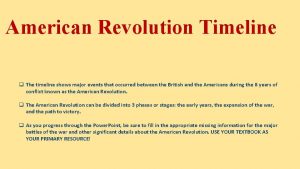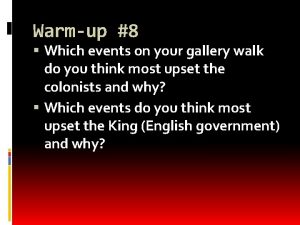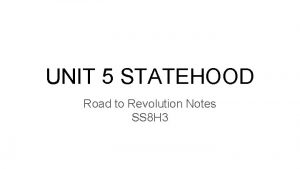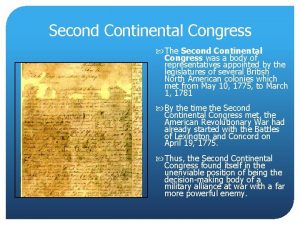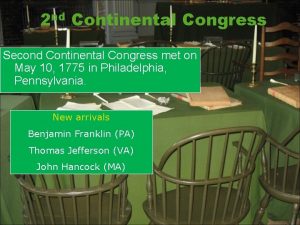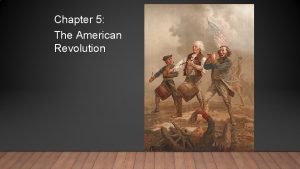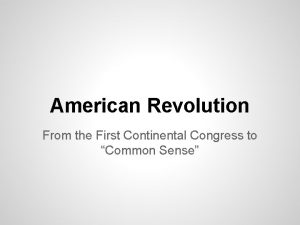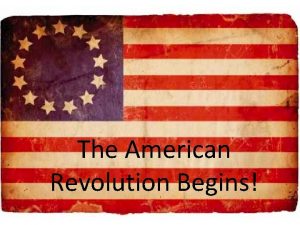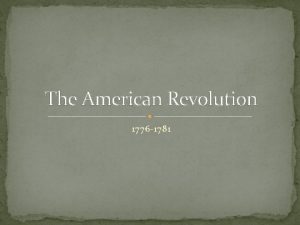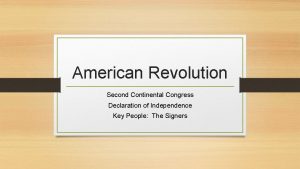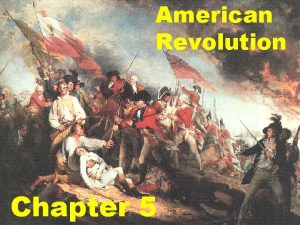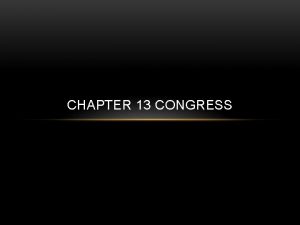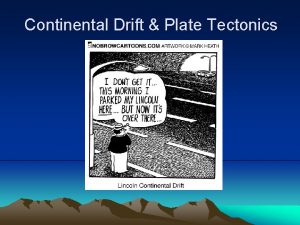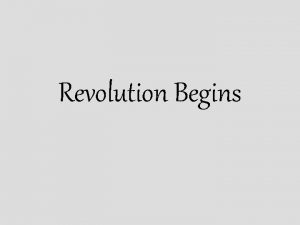Ch 4 The American Revolution First Continental Congress





























- Slides: 29

Ch 4 The American Revolution

First Continental Congress • 56 delegates • Carpenter’s Hall, Philadelphia • Middle-aged, well-educated, property owners • Intense debates whether to fight of seek peace

• Encouraged peaceful boycotts of British goods • Began preparing for war • Drafted a Declaration of Rights

Battles of Lexington and Concord • More British troops arrive in Boston • More American Militia are being organized


Battles of Lexington and Concord • Gage learned of a military arsenal in Concord • Sent troops to capture the weapons • Spies were aware of Gage’s plan


• Revere and others got the lantern signal from the Old North Church • They rode through the countryside yelling “the regulars are coming!” • Revere was captured by British troops and later released



• Seventy armed minutemen waited for the British at Lexington • A British officer yelled “fire!” and the shooting started • Militia ran • Redcoats continued their last six miles to Concord

• Alarm bells rang in Concord • British soldiers took what they could find and tried to burn the rest • British were getting surrounded and had to retreat back to Boston

Second Continental Congress Organized an army and Appointed George Washington Commander of Continental Army Introduced the Articles of Confederation Enlisted service of Experienced European Military officers Major contributions of Second Continental Congress Offered Olive Branch Petition Decided to issue Paper money to pay conflicts

• After the Battles of Lexington and Concord, the two armies faced off in Boston • "Don't fire until you see the whites of their eyes. “ • Battle of Bunker Hill was fought on Breed’s Hill


Battle of Bunker Hill • Two attacks of the hill were turned back • Americans were soon running out of ammunition • On third attack the British succeeded in overrunning them • Most of the Americans were able to withdraw • Thirty were caught and killed by the British

Battle of Bunker Hill • British casualties were 1000 • American casualties were 450




Dorchester Heights • Washington had the guns from Fort Ticonderoga brought in. • Henry Knox brought 59 guns 300 miles. • Washington took Dorchester Heights and the British left Boston.




Common Sense • Common Sense was the most influential political pamphlet ever written. • Common Sense was written for the ‘common man’; men who would shed their blood in the rebellion.

Declaring Independence • Common Sense - huge impact on hearts and minds of Americans. • On July 2, 1776, the Second Continental Congress declared independence from Great Britain.

• A 5 member committee prepared the Declaration • The Declaration was written by Thomas Jefferson


• The Declaration was adopted on July 4, 1776.
 First continental congress definition
First continental congress definition First continental congress
First continental congress What was the goal of the first continental congress?
What was the goal of the first continental congress? First continental congress convenes
First continental congress convenes The first continental congress
The first continental congress How could the french revolution have been avoided
How could the french revolution have been avoided Convergent transform
Convergent transform Plate boundary
Plate boundary Russian revolution vs french revolution
Russian revolution vs french revolution Third agricultural revolution definition
Third agricultural revolution definition Main causes of the american revolution
Main causes of the american revolution Peter zenger american revolution
Peter zenger american revolution American revolution facts
American revolution facts American revolution diorama
American revolution diorama American revolution digital breakout answers
American revolution digital breakout answers American revolution strengths and weaknesses
American revolution strengths and weaknesses King during american revolution
King during american revolution Long term causes french revolution
Long term causes french revolution King during american revolution
King during american revolution Effects of american revolution
Effects of american revolution Discuss the following questions
Discuss the following questions The american revolution chapter 6 section 4
The american revolution chapter 6 section 4 Liberty the american revolution episode 3
Liberty the american revolution episode 3 Latin american revolution date
Latin american revolution date American revolution jeopardy
American revolution jeopardy Latin american revolution definition ap world history
Latin american revolution definition ap world history Latin americans in france
Latin americans in france Road to american revolution timeline
Road to american revolution timeline Causes of the american revolution gallery walk
Causes of the american revolution gallery walk American revolution cloze notes
American revolution cloze notes
